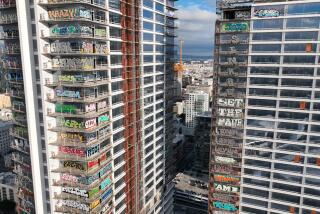Theme Park and Aquarium Added to Plan for Waterfront : Tourism: City officials react favorably to architect’s concept, although no cost figures are available for the expanded tourist harbor that would replace Shoreline Aquatic Park.
- Share via
LONG BEACH — A consulting firm has expanded its vision for a new downtown waterfront, adding a theme park and an aquarium to its plan for a bustling tourist harbor.
Stanton Eckstut of Ehrenkrantz & Eckstut Architects of New York presented the detailed development plan Tuesday to the Long Beach City Council and Board of Harbor Commissioners.
In August, the two bodies approved general development concepts in the plan, which calls for a quaint restaurant and shopping district and could include the Queen Mary.
City officials, who took no action Tuesday, generally reacted favorably to the plan. They are expected in the next several weeks to authorize Ehrenkrantz & Eckstut to determine how much it will cost the city and the port for the development.
The firm is being paid $395,000 to develop the plan.
“Overall, the plan is excellent,” said Mayor Ernie Kell, one of the most vocal proponents of a tourist harbor. “I see endless opportunities for Long Beach.”
The city and the port are expected to pay the cost of creating the harbor. Private developers would pay for buildings and other improvements to be part of the project.
City officials hope that such a development would bring the city tax dollars and hundreds of new jobs.
Councilman Warren Harwood said he could not be enthusiastic about the plan until he knows more about the costs, which he said would probably exceed $100 million. “We’re getting the community all worked up, and we don’t know the feasibility of this,” he said.
Eckstut said his firm could determine the cost of the project by early January.
To create the harbor, Shoreline Aquatic Park would be excavated and its lagoon dredged. The harbor would be bound by Shoreline Village on the east and Queens Way on the west.
A pier would be built extending into the middle of the harbor. The aquarium would be built on the pier, and the Queen Mary could be moored on one side if city officials choose to include the ocean liner in the proposed development. The theme park, probably ocean-oriented, would be on the west side of the harbor.
A quaint shopping and restaurant district would be developed between Magnolia and Pine avenues, from Seaside Way south to Shoreline Drive. Shoreline Drive, which has the feel of a freeway, would have its off-ramps removed. It would have stores and restaurants on one side and the pier and tourist harbor on the other.
The area would have rental paddle boats, dinner, cruise and tour boats, dining, and entertainment “going day and night,” Eckstut told city officials.
A cruise ship terminal, which would eventually accommodate five ships, and a pleasure boat marina would be built in the area where the Queen Mary is moored, across Queens Way Bridge.
The consultant’s plan also calls for creation of an eight-acre park in the same area, as well as greenbelts around the harbor. Forty-eight acres of park and greenbelt would compensate for the loss of 33-acre Shoreline Aquatic Park, Eckstut said.
Councilman Alan Lowenthal said he is concerned that the proposed eight-acre park might be too difficult to reach. “I want to make sure people have access to parkland,” he said.
Environmental issues would also need to be addressed before the development could move forward.
A recent marine survey conducted by consultant Dames & Moore of Santa Ana indicates that Shoreline Aquatic Park and its lagoon are habitat for various species of fish, including topsmelt, gobies and grunion, and birds including the Western sandpiper and marbled godwit.
The development plan calls for new habitat to be established near the proposed park.
The California Coastal Commission, among other agencies, would have to approve the development. The commission would weigh whether the development would significantly harm wildlife or otherwise violate the Coastal Act of 1976, which requires diverse use of coastal lands.
More to Read
Sign up for Essential California
The most important California stories and recommendations in your inbox every morning.
You may occasionally receive promotional content from the Los Angeles Times.










